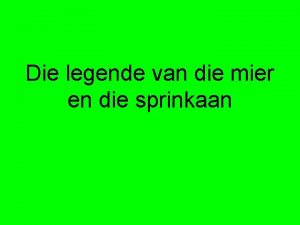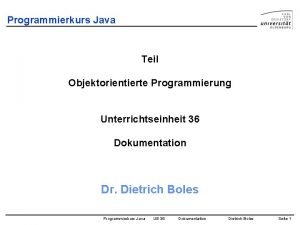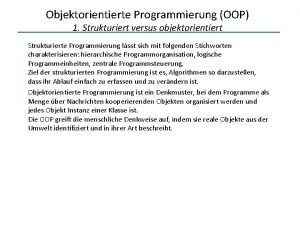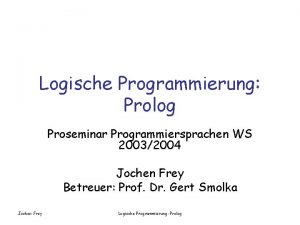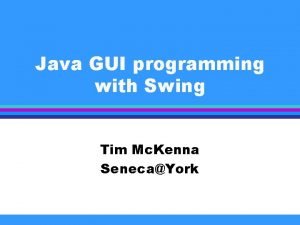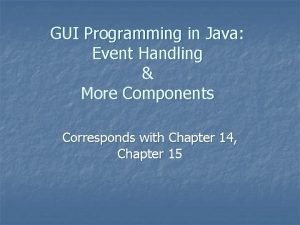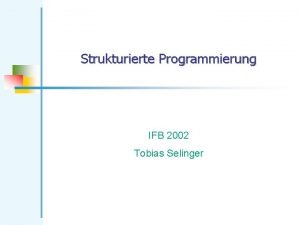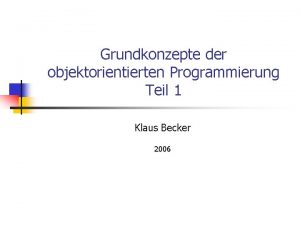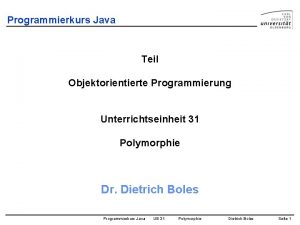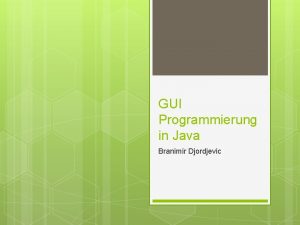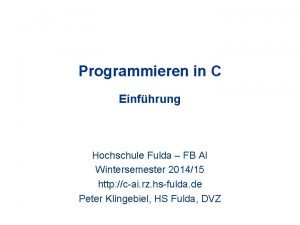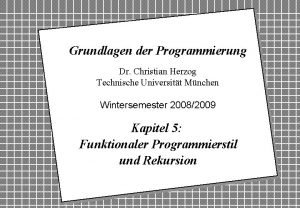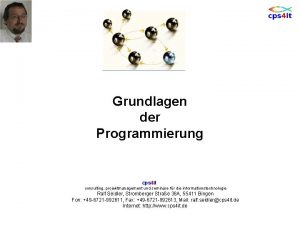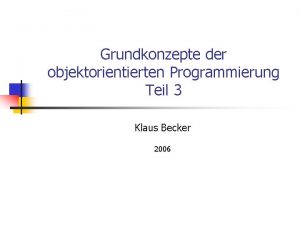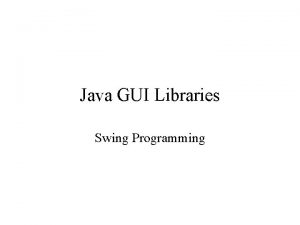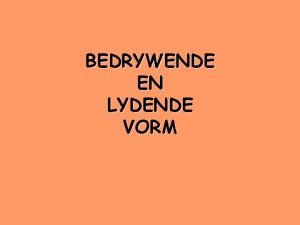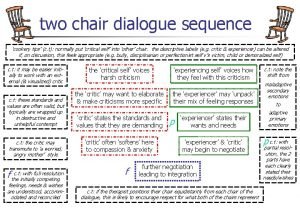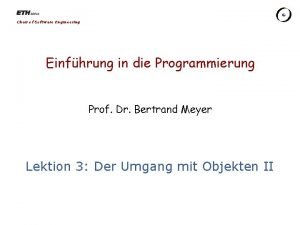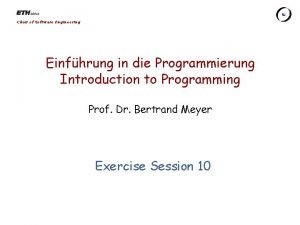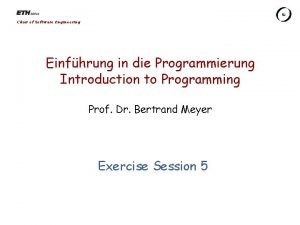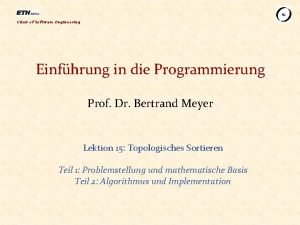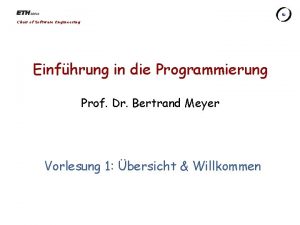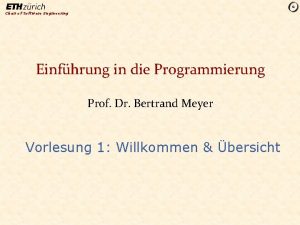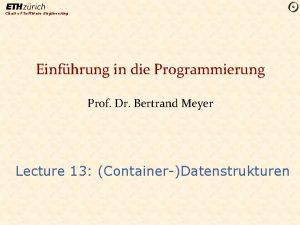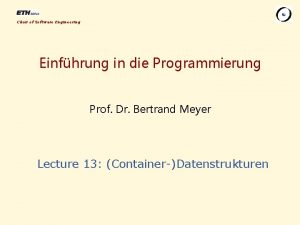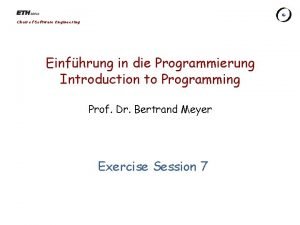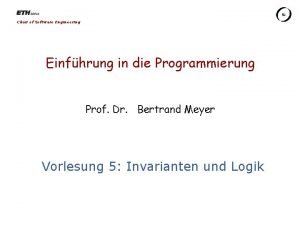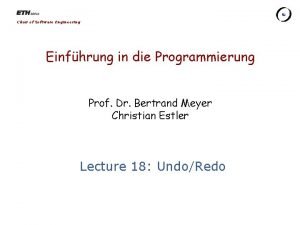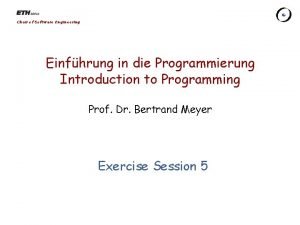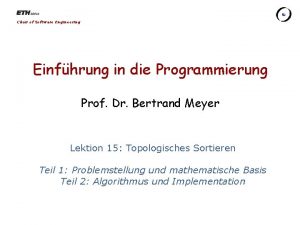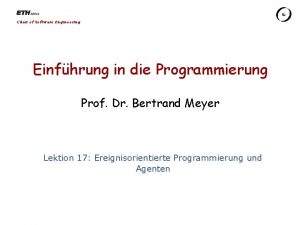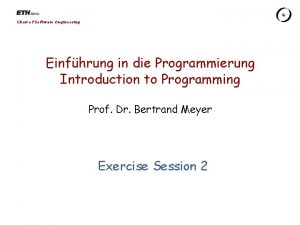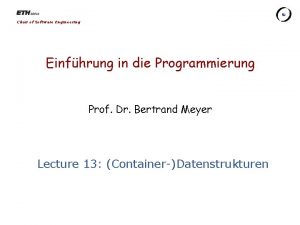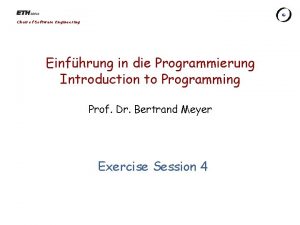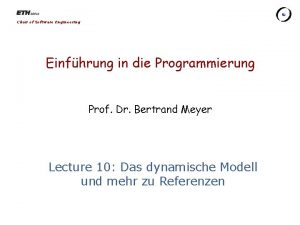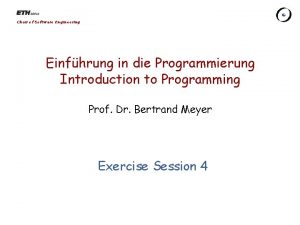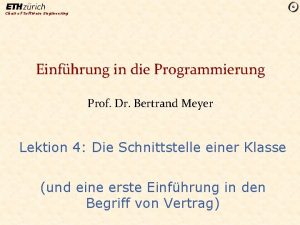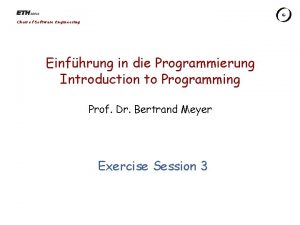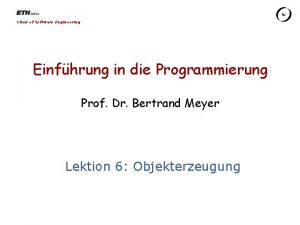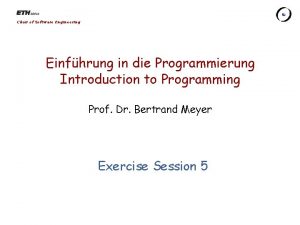Chair of Software Engineering Einfhrung in die Programmierung
































![An example person, person 1 : PERSON personnel_directory : HASH_TABLE [PERSON, STRING ] create An example person, person 1 : PERSON personnel_directory : HASH_TABLE [PERSON, STRING ] create](https://slidetodoc.com/presentation_image_h2/597ded0f2d928ab2c58c6dc8d515c210/image-33.jpg)

![Collision handling Open hashing: ARRAY [LINKED_LIST [G]] 36 Collision handling Open hashing: ARRAY [LINKED_LIST [G]] 36](https://slidetodoc.com/presentation_image_h2/597ded0f2d928ab2c58c6dc8d515c210/image-35.jpg)
![A better technique: closed hashing Class HASH_TABLE [G, H] implements closed hashing: HASH_TABLE [G, A better technique: closed hashing Class HASH_TABLE [G, H] implements closed hashing: HASH_TABLE [G,](https://slidetodoc.com/presentation_image_h2/597ded0f2d928ab2c58c6dc8d515c210/image-36.jpg)












- Slides: 48

Chair of Software Engineering Einführung in die Programmierung Introduction to Programming Prof. Dr. Bertrand Meyer Lecture 14: Container Data Structures

Topics for this lecture Containers and genericity Container operations Lists Arrays Assessing algorithm performance: Big-O notation Hash tables Stacks and queues 2

Container data structures Contain other objects (“items”) Some fundamental operations on a container: Ø Insertion: add an item Ø Removal: remove an occurrence (if any) of an item Ø Wipeout: remove all occurrences of an item Ø Search: find out if a given item is present Ø Iteration (or “traversal”): apply a given operation to every item Various container implementations, as studied next, determine: Ø Which of these operations are available Ø Their speed Ø The storage requirements This lecture is just an intro; see “Data Structures and Algorithms” (second semester course) for an in-depth study 4

A familiar container: the list before after item index 1 forth back start count Cursor To facilitate iteration and other operations, our lists have cursors (here internal, can be external) finish Queries Commands 5

A standardized naming scheme Container classes in Eiffel. Base use standard names for basic container operations: is_empty : BOOLEAN has (v : G ): BOOLEAN count : INTEGER item : G make put (v : G ) remove (v : G ) wipe_out start, finish forth, back Whenever applicable, use them in your own classes as well 6

Bounded representations In designing container structures, avoid hardwired limits! “Don’t box me in”: Eiffel. Base is paranoid about hard limits Most structures conceptually unbounded Ø Even arrays (bounded at any particular time) are resizable Ø When a structure is bounded, the maximum number of items is called capacity, with an invariant count <= capacity 7

Containers and genericity How do we handle variants of a container class distinguished only by the item type? Solution: genericity allows explicit type parameterization consistent with static typing Container structures are implemented as generic classes: LINKED_LIST [G ] pl : LINKED_LIST [PERSON ] sl : LINKED_LIST [STRING ] al : LINKED_LIST [ANY ] 8

Lists A list is a container keeping items in a defined order Lists in Eiffel. Base have cursors before after item index 1 forth back start count Cursor finish 9

Cursor properties (all in class invariant!) The cursor ranges from 0 to count + 1: 0 <= index <= count + 1 The cursor is at position 0 if and only if before holds: before = (index = 0 ) It is at position count + 1 if and only if after holds: after = (index = count + 1 ) In an empty list the cursor is at position 0: is_empty = (count = 0 ) 10

A specific implementation: (singly) linked lists 11

Caveat Whenever you define a container structure and the corresponding class, pay attention to borderline cases: Ø Empty structure Ø Full structure (if finite capacity) 12

Adding a cell 13

The corresponding command put_right (v : G) -- Add v to right of cursor position; do not move cursor. require not_after: not after local p : LINKABLE [G] do create p. make (v) if before then p. put_right (first_element) first_element : = p active : = p else p. put_right (active. right) active. put_right (p) end count : = count + 1 ensure next_exists: active. right /= Void inserted: (not old before) implies active. right. item = v inserted_before: (old before) implies active. item = v end 14

Removing a cell 15

The corresponding command Do remove as an exercise 16

Inserting at the end: extend 17

Arrays An array is a container storing items in a set of contiguous memory locations, each identified by an integer index lower 1 item (4 ) 2 3 4 upper 5 6 7 Valid index values 18

Bounds and indexes Arrays are bounded: lower : INTEGER -- Minimum index upper : INTEGER -- Maximum index The capacity of an array is determined by the bounds: capacity = upper – lower + 1 19

Accessing and modifying array items item (i : INTEGER) : G -- Entry at index i, if in index interval. require valid_key: valid_index (i ) put (v : G; i : INTEGER) -- Replace i-th entry, if in index interval, by v. require valid_key: valid_index (i ) ensure inserted: item (i ) = v 20

Eiffel note: simplifying the notation Feature item is declared as item (i : INTEGER) alias ″[ ]″ : G assign put This allows the following synonym notations: a [i ] . a item (i ) : = x a [i ] : = x . for a item (i ) for . . a put (x, i ) for a put (x, i ) These facilities are available to any class A class may have at most one feature aliased to “[]” 21

Resizing an array At any point in time arrays have a fixed lower and upper bound, and thus a fixed capacity Unlike most other programming languages, Eiffel allows resizing an array (resize) Feature force resizes an array if required: unlike put, it has no precondition Resizing usually requires reallocating the array and copying the old values. Such operations are costly! 22

Using an array to represent a list See class ARRAYED_LIST in Eiffel. Base Introduce count (number of elements in the list) The number of list items ranges from 0 to capacity : 0 <= count <= capacity An empty list has no elements: is_empty = (count = 0) 23

Linked or arrayed list? The choice of a container data structure depends on the speed of its container operations The speed of a container operation depends on how it is implemented, on its underlying algorithm 24

How fast is an algorithm? Depends on the hardware, operating system, load on the machine. . . But most fundamentally depends on the algorithm! 25

Algorithm complexity: “big-O” notation Let n be the size of the data structure (count ). “f is O ( g (n))” means that there exists a constant k such that n : n, |f (n)| k |g (n)| Defines function not by exact formula but by order of magnitude, e. g. O (1), O (log count), O (count 2), O (2 count). 7 count 2 + 20 count + 4 is O (count 2) 26

Examples put_right of LINKED_LIST: O (1) Regardless of the number of elements in the linked list it takes a constant time to insert an item at cursor position. force of ARRAY: O (count) At worst the time for this operation grows proportionally to the number of elements in the array. 27

Why neglect constant factors? Consider algorithms with complexity O (n ) O (n 2) O (2 n ) Assume your new machine (Christmas is coming!) is 1000 times faster? How much bigger a problem can you solve in one day of computation time? 28

Variants of algorithm complexity We may be interested in Ø Worst-case performance Ø Best-case performance (seldom) Ø Average performance (needs statistical distribution) Unless otherwise specified this discussion considers worst -case Lower bound notation: (n ) 29

Cost of singly-linked list operations Operation Feature Complexity put_right O (1) extend O (count) O (1) remove_right O (1) remove O (count) Index-based access i_th O (count) Search has O (count) Insert right to cursor Insert at end Remove right neighbor Remove at cursor position 30

Cost of doubly-linked list operations Operation Feature Complexity put_right O (1) extend O (1) remove_right O (1) remove O (1) Index-based access i_th O (count) Search has O (count) Insert right to cursor Insert at end Remove right neighbor Remove at cursor position 31

Cost of array operations Operation Feature Complexity Index-based access item O (1) Index-based replacement put O (1) Index-based replacement outside of current bounds force O (count) has O (count) - O (log count) Search in sorted array 32

Hash tables Both arrays and hash tables are indexed structures; item manipulation requires an index or, in case of hash tables, a key. Unlike arrays hash tables allow keys other than integers. 33
![An example person person 1 PERSON personneldirectory HASHTABLE PERSON STRING create An example person, person 1 : PERSON personnel_directory : HASH_TABLE [PERSON, STRING ] create](https://slidetodoc.com/presentation_image_h2/597ded0f2d928ab2c58c6dc8d515c210/image-33.jpg)
An example person, person 1 : PERSON personnel_directory : HASH_TABLE [PERSON, STRING ] create personnel_directory. make (100) Storing an element: create person 1 personnel_directory. put (person 1, ”Annie”) Retrieving an element person : = personnel_directory. item (”Annie”) 34

Hash function The hash function maps K, the set of possible keys, into an integer interval a. . b. A perfect hash function gives a different integer value for every element of K. Whenever two different keys give the same hash value a collision occurs. 35
![Collision handling Open hashing ARRAY LINKEDLIST G 36 Collision handling Open hashing: ARRAY [LINKED_LIST [G]] 36](https://slidetodoc.com/presentation_image_h2/597ded0f2d928ab2c58c6dc8d515c210/image-35.jpg)
Collision handling Open hashing: ARRAY [LINKED_LIST [G]] 36
![A better technique closed hashing Class HASHTABLE G H implements closed hashing HASHTABLE G A better technique: closed hashing Class HASH_TABLE [G, H] implements closed hashing: HASH_TABLE [G,](https://slidetodoc.com/presentation_image_h2/597ded0f2d928ab2c58c6dc8d515c210/image-36.jpg)
A better technique: closed hashing Class HASH_TABLE [G, H] implements closed hashing: HASH_TABLE [G, H] uses a single ARRAY [G] to store the items. At any time some of positions are occupied and some free: 37

Closed hashing If the hash function yields an already occupied position, the mechanism will try a succession of other positions (i 1, i 2, i 3) until it finds a free one: With this policy and a good choice of hash function search and insertion in a hash table are essentially O (1). 38

Cost of hash table operations Operation Feature Complexity item O (1) O (count) put, extend O (1) O (count) Removal remove O (1) O (count) Key-based replacement replace O (1) O (count) has O (1) O (count) Key-based access Key-based insertion Search 39

Dispensers Unlike indexed structures, as arrays and hash tables, there is no key or other identifying information for dispenser items. Dispensers are container data structures that prescribe a specific retrieval policy: Ø Last In First Out (LIFO): choose the element inserted most recently stack. Ø First In First Out (FIFO): choose the oldest element not yet removed queue. Ø Priority queue: choose the element with the highest priority. 40

Dispensers 41

Stacks A stack is a dispenser applying a LIFO policy. The basic operations are: Push an item to the top of the stack (put) Pop the top element (remove) Access the top element (item) Top Body, what would remain after popping. A new item would be pushed here 42

An example: Polish expression evaluation from until loop “All terms of Polish expression have been read” “Read next term x in Polish expression” if “x is an operand” then s put (x) else -- x is a binary operator -- Obtain and pop two top operands: op 1 : = s item; s remove op 2 : = s item; s remove -- Apply operator to operands and push result: s put (application (x, op 2, op 1)) end . . . end 43

Applications of stacks Many! Ubiquitous in programming language implementation: Ø Parsing expressions (see next) Ø Managing execution of routines (“THE stack”) Special case: implementing recursion Ø Traversing trees Ø … 44

Evaluating 2 a b + c d - * + b 2 c a a (a+b) 2 2 d c (c-d) (a+b)*(c-d) 2 2+(a+b)*(c-d) 45

The run-time stack contains the activation records for all currently active routines. An activation record contains a routine’s locals (arguments and local entities). 46

Implementing stacks Common stack implementations are either arrayed or linked. 47

Choosing between data structures Use a linked list if: Ø Order between items matters Ø The main way to access them is in that order Ø (Bonus condition) No hardwired size limit Use an array if: Ø Each item can be identified by and integer index Ø The main way to access items is through that index Ø Hardwired size limit (at least for long spans of execution) Use a hash table if: Ø Every item has an associated key Ø The main way to access them is through these keys Ø The structure is bounded Use a stack: Ø For a LIFO policy Ø Example: traversal of nested structures such as trees Use a queue: Ø For a FIFO policy Ø Example: simulation of FIFO phenomenon 48

What we have seen Container data structures: basic notion, key examples Algorithm complexity (“Big-O”) How to choose a particular kind of container 49
 Die mier en die sprinkaan
Die mier en die sprinkaan Programmierung dokumentation beispiel
Programmierung dokumentation beispiel Funktionale vs objektorientierte programmierung
Funktionale vs objektorientierte programmierung Funktionale programmierung tu dortmund
Funktionale programmierung tu dortmund Robo pro coding
Robo pro coding Prolog programmierung
Prolog programmierung Gui programmierung java
Gui programmierung java Gui programmierung java
Gui programmierung java Programmierung
Programmierung Strukturierte programmierung beispiel
Strukturierte programmierung beispiel Grundidee objektorientierte programmierung
Grundidee objektorientierte programmierung Polymorphie java
Polymorphie java Branimir djordjevic
Branimir djordjevic Blockprogrammierung
Blockprogrammierung Hs fulda ai
Hs fulda ai Funktionale programmierung tum
Funktionale programmierung tum Abweisschleife
Abweisschleife Objekt orientiert programmierung
Objekt orientiert programmierung Java ui libraries
Java ui libraries Computer based system engineering in software engineering
Computer based system engineering in software engineering Forward engineering in software engineering
Forward engineering in software engineering Software maintenance in software engineering ppt
Software maintenance in software engineering ppt What is software implementation in software engineering
What is software implementation in software engineering Metrics computer science
Metrics computer science Example of software crisis
Example of software crisis Software metrics example
Software metrics example Real time software design in software engineering
Real time software design in software engineering Design principles in software engineering
Design principles in software engineering Die kinder verbringen die ferien
Die kinder verbringen die ferien Je höher die berge desto schöner die gams
Je höher die berge desto schöner die gams Voorbeelde van korttermyn doelwitte
Voorbeelde van korttermyn doelwitte South park college know it all hippies
South park college know it all hippies Die einde van die koue oorlog 1989
Die einde van die koue oorlog 1989 Belydenis van geloof ek glo in god die vader
Belydenis van geloof ek glo in god die vader Pad van waarheid tot die lewe
Pad van waarheid tot die lewe Lydende vorm voorbeelde
Lydende vorm voorbeelde 2folie
2folie Jys die stem in die stilte wat agterbly
Jys die stem in die stilte wat agterbly Rosen die ich an dich verschenke
Rosen die ich an dich verschenke Het is niet die ene druppel die de emmer doet overlopen
Het is niet die ene druppel die de emmer doet overlopen Mutter bumst sohn
Mutter bumst sohn Pad van waarheid tot die lewe
Pad van waarheid tot die lewe Pad van waarheid en lewe
Pad van waarheid en lewe Daarom voegwoord
Daarom voegwoord Engineering elegant systems: theory of systems engineering
Engineering elegant systems: theory of systems engineering Engineering elegant systems: theory of systems engineering
Engineering elegant systems: theory of systems engineering Forward and reverse engineering
Forward and reverse engineering Pencil a or an
Pencil a or an Two chair dialogue
Two chair dialogue
